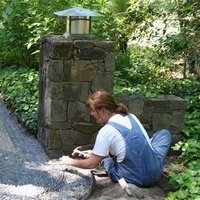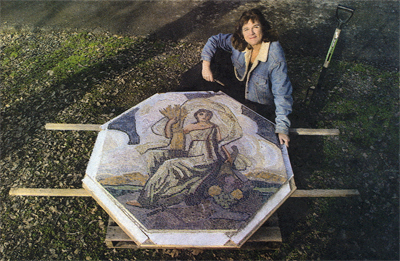New York Times: The secrets of the Moors, transplanted to California
 Summary: Ken Druse
New York Times News Service
Dec. 7, 2005 12:00 AM
Summary: Ken Druse
New York Times News Service
Dec. 7, 2005 12:00 AM
Ken Druse
New York Times News Service
Dec. 7, 2005 12:00 AM
The secrets of the Moors, transplanted to California
Brandon Tyson dropped out of college in 1969 and moved from southern Georgia to San Francisco in search of excitement. He found it in plants. "Everything growing here was exotic to me," he said. "It was a revelation. I felt like I'd entered the Garden of Eden."
Tyson, a garden designer, describes his work as "plant-driven," and it is his extravagant use of thousands of species and varieties in naturalistic plantings that has made him one of Northern California's most sought-after designers. "If I had my way, people touring my gardens would need a machete to get through them," he said. "I love having that much life around, being totally wrapped in plants."
So it was something of a departure when Alber Saleh and Bart Jones hired him five years ago to design a garden in the Moorish style known for straight lines and spare plantings. Saleh had seen Tyson's work in a Marin County garden where paths zigzag through an exuberant jungle filled with bananas, palms and giant bird-of-paradise plants with foot-long black-and-white flowers.
advertisement
What Saleh and Jones did not know was that Tyson had visited the Moorish gardens of Andalusia in southern Spain, which were created by Arab and Berber Muslims from North Africa. He was especially taken by the enclosed gardens sheltered from the heat and sun.
Moorish gardens usually have a rigid geometry centered on a water source, like a well or fountain. Fruit trees and flowering shrubs, planted in holes or pits cut into paving, flank an irrigating water course, or runnel, that flows the length of the garden. Other plantings nestle against the walls and beneath columned arcades, which shelter them from the desiccating winds and blazing sun, and protect the grounds from intruders. (In this case the walls have the added benefit of keeping out marauding rattlesnakes.)
The Islamic style continues to inspire designers like Tyson, and looks appropriate in the sun-baked hills surrounding the Sonoma Valley home of Saleh and Jones, in the wine country 40 miles north of San Francisco. Iron gates and a portico lead to a courtyard within the cloistered walls of the U-shape house. The stucco walls and the garden's tile paving absorb heat by day and radiate it back to the plants at night. As a result, Tyson could use leafy, cold-sensitive species that would not otherwise survive an exposed site in this area, where temperatures occasionally dip into the 20s.
"Delivery guys come," said Jones, a real-estate developer, "and when they see plants like bananas growing here, their jaws drop."
Jones is something of an amateur aquatic engineer, and he fine-tuned the garden's waterworks himself. A terra cotta fountain in the shape of an artichoke fills a tiled pool at the center of the courtyard, which in turn spills water into a runnel flowing down steps to a swimming pool. Before it reaches its destination, the water dives under the pavement and re-emerges at a bronze fountain that Saleh, a mortgage broker, designed after a similar one at the Alhambra in Spain. When Saleh's father first saw the house, he pointed out a broken roof tile. "I didn't know how to tell him," Saleh laughed. "We'd paid extra for that."
Despite the appearance of age, the five-year-old house, designed in the Andalusian style by R. Gary Black, a professor of architecture at the University of California, Berkeley, has modern passive-solar construction with stucco walls over an insulating core of hay bales. The garden in front of the house is just entering its second year. Not quite in the Moorish style, the plantings are an interpretation of nature beyond the walls of the house. It is easy to imagine the botanical magic carpet the plantings will soon become.
Tyson describes the garden as "Moroccan modern," and for him, the modernity comes from the plants, many of which are new to cultivation, like Leucadendron Safari Sunshine, a variety of a South African shrub with brilliant beet-red young growth that ages to stripes of cream and green. Swaths and rivulets of succulents thrive along the path leading to the front door. Concrete pavers cast in place were designed to look like irregular flagstones. The spaces between these stones are filled with inch-tall Dymondia margaretae, a ground cover with malachite-colored leaves edged in silver that can be walked on.
The path widens into a circle where tan and black pebble paving by Anne Ziemienski, a local artist, forms a multi-pointed star at the base of another tiled pool, this one with a bronze fountain shaped like an onion dome.
The view from the garden is of buff-brown hills etched with vertical green lines in the midground formed by tall Italian cypress.
From the beginning, Saleh had wanted the cypress, the ubiquitous slender accents of classical Mediterranean gardens. But Tyson felt the near-black needles of the species would look like flat silhouettes, and campaigned for an especially vivid and rare variety, Swane's Gold, which has year-round spring-green needles.
His dogged pursuit led him to a nurseryman who had propagated the trees for himself nearly 30 years ago. By mustering all his Southern charm, Tyson persuaded him last spring to sell all nine of them. The green cypress trees provided an unexpected bonus, a visual balance with the garden's most arresting botanical feature: the 14 Washingtonia palms, each of them 30 feet tall, around the courtyard and swimming pool. Before the cypress, the palms had looked naked, like arrows shooting skyward. The solid cypress columns now echo the palms' verticality, a visual complement that also grounds them.
Much of Tyson's approach to this garden, where West meets East, was to allude to Moorish design by using plants as architectural elements.
To meet Saleh's request for tropical drama, he capitalized on the courtyard's microclimate, and the elevation of the location itself.
"Frost is like water," Tyson said, explaining that cold air drains away from the house's hilltop site.
Of course, when garden designers challenge the climate, there may be losses. So far, Jones and Saleh have been fortunate, but as Tyson points out, "Plants die. We all die."
But he has encouraged his clients to revel in the plants' mutability. Now they rush outdoors every day to see what is coming into bloom, what has ripening fruit or luscious perfume, or simply what has grown a millimeter (or in the case of some tropical plants, several inches) larger than the day before.



